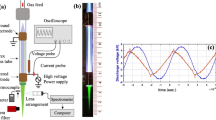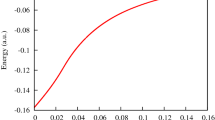Abstract
Nicolet and Dogniaux1, in their investigations on auroral spectra, found that the blend of (2,0) and (3,1) bands of the O2+ first negative system (b4Σ−g→a4πu) would satisfactorily explain the so-called ‘second green auroral line’, observed by Vegard, which extends from λ 5258 Å to λ 5289 Å with a sharp edge at λ 5258 Å (compare with ref. 2).
This is a preview of subscription content, access via your institution
Access options
Subscribe to this journal
Receive 51 print issues and online access
$199.00 per year
only $3.90 per issue
Buy this article
- Purchase on Springer Link
- Instant access to full article PDF
Prices may be subject to local taxes which are calculated during checkout
Similar content being viewed by others
References
Nicolet, M., and Dogniaux, R., J. Geophys. Res., 55, 21 (1950).
Swings, P., and Meinel, A. B., The Atmosphere of Earth and Planets, edit. by Kuiper, G. P., 159 (Chicago Univ. Press, 1948).
Rao, P. S. R. thesis, University of Saugar (1960).
Rao, P. S. R., Proc. Phys. Soc., 81, 240 (1963).
Herzberg, G., Molecular Spectra and Molecular Structure—Spectra of Diatomic Molecules, 486 (Van Nostrand Co., Inc., New York) (1953).
Author information
Authors and Affiliations
Rights and permissions
About this article
Cite this article
RAO, P. A Comparison of Intensities of the O2+ (First Negative) Bands excited in a Hollow-cathode Discharge and in Auroræ. Nature 201, 1112–1113 (1964). https://doi.org/10.1038/2011112a0
Issue Date:
DOI: https://doi.org/10.1038/2011112a0
Comments
By submitting a comment you agree to abide by our Terms and Community Guidelines. If you find something abusive or that does not comply with our terms or guidelines please flag it as inappropriate.



